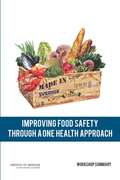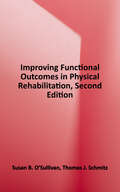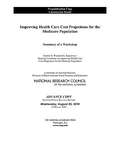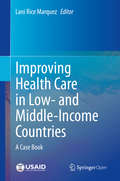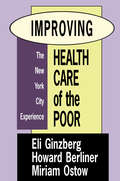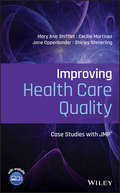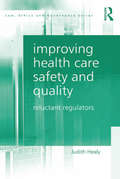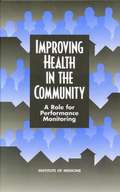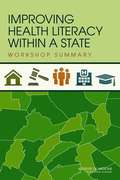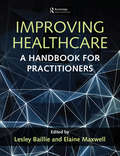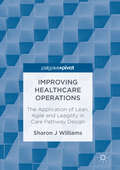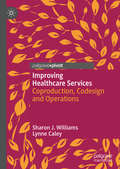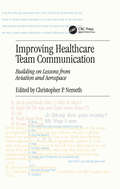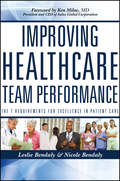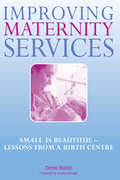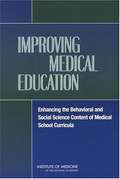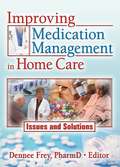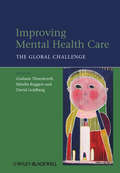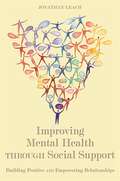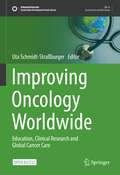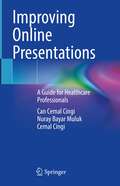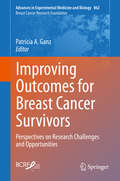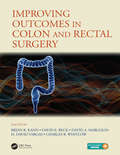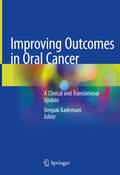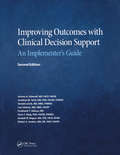- Table View
- List View
Improving Food Safety Through a One Health Approach
by Eileen R. ChoffnesGlobalization of the food supply has created conditions favorable for the emergence, reemergence, and spread of food-borne pathogens-compounding the challenge of anticipating, detecting, and effectively responding to food-borne threats to health. In the United States, food-borne agents affect 1 out of 6 individuals and cause approximately 48 million illnesses, 128,000 hospitalizations, and 3,000 deaths each year. This figure likely represents just the tip of the iceberg, because it fails to account for the broad array of food-borne illnesses or for their wide-ranging repercussions for consumers, government, and the food industry-both domestically and internationally. A One Health approach to food safety may hold the promise of harnessing and integrating the expertise and resources from across the spectrum of multiple health domains including the human and veterinary medical and plant pathology communities with those of the wildlife and aquatic health and ecology communities. The IOM's Forum on Microbial Threats hosted a public workshop on December 13 and 14, 2011 that examined issues critical to the protection of the nation's food supply. The workshop explored existing knowledge and unanswered questions on the nature and extent of food-borne threats to health. Participants discussed the globalization of the U. S. food supply and the burden of illness associated with foodborne threats to health; considered the spectrum of food-borne threats as well as illustrative case studies; reviewed existing research, policies, and practices to prevent and mitigate foodborne threats; and, identified opportunities to reduce future threats to the nation's food supply through the use of a "One Health" approach to food safety. Improving Food Safety Through a One Health Approach: Workshop Summary covers the events of the workshop and explains the recommendations for future related workshops.
Improving Functional Outcomes in Physical Rehabilitation
by Susan B. O'Sullivan Thomas J. SchmitzAchieve the best functional outcomes for your patients. Here is a practical, step-by-step guide to understanding the treatment process and selecting the most appropriate intervention for your patient. Superbly illustrated, in-depth coverage shows you how to identify functional deficits, determine what treatments are appropriate, and then implement them to achieve the best functional outcome for your patients. This one-of-a-kind resource features case studies in the text accompanied by videos online at DavisPlus that demonstrate how the interventions selected make a difference in your patients’ lives.
Improving Health Care Cost Projections for the Medicare Population: Summary of a Workshop
by National Research Council of the National AcademiesDeveloping credible short-term and long-term projections of Medicare health care costs is critical for public- and private-sector policy planning, but faces challenges and uncertainties. There is uncertainty not only in the underlying economic and demographic assumptions used in projection models, but also in what a policy modeler assumes about future changes in the health status of the population and the factors affecting health status , the extent and pace of scientific and technological breakthroughs in medical care, the preferences of the population for particular kinds of care, the likelihood that policy makers will alter current law and regulations, and how each of these factors relates to health care costs for the elderly population. Given the substantial growth in the Medicare population and the continued increases in Medicare, Medicaid, and private health insurance spending, the availability of well-specified models and analyses that can provide useful information on the likely cost implications of health care policy alternatives is essential. It is therefore timely to review the capabilities and limitations of extant health care cost models and to identify areas for research that offer the most promise to improve modeling, not only of current U.S. health care programs, but also of policy alternatives that may be considered in the coming years. The National Research Council conducted a public workshop focusing on areas of research needed to improve health care cost projections for the Medicare population, and on the strengths and weaknesses of competing frameworks for projecting health care expenditures for the elderly. The workshop considered major classes of projection and simulation models that are currently used and the underlying data sources and research inputs for these models. It also explored areas in which additional research and data are needed to inform model development and health care policy analysis more broadly. The workshop, summarized in this volume, drew people from a wide variety of disciplines and perspectives, including federal agencies, academia, and nongovernmental organizations.
Improving Health Care in Low- and Middle-Income Countries: A Case Book
by Lani Rice MarquezThis open access book is a collection of 12 case studies capturing decades of experience improving health care and outcomes in low- and middle-income countries. Each case study is written by healthcare managers and providers who have implemented health improvement projects using quality improvement methodology, with analysis from global health experts on the practical application of improvement methods. The book shows how frontline providers in health and social services can identify gaps in care, propose changes to address those gaps, and test the effectiveness of their changes in order to improve health processes and outcomes. The chapters feature cases that provide real-life examples of the challenges, solutions, and benefits of improving healthcare quality and clearly demonstrate for readers what quality improvement looks like in practice:Addressing Behavior Change in Maternal, Neonatal, and Child Health with Quality Improvement and Collaborative Learning Methods in GuatemalaHaiti’s National HIV Quality Management Program and the Implementation of an Electronic Medical Record to Drive Improvement in Patient CareScaling Up a Quality Improvement Initiative: Lessons from Chamba District, IndiaPromoting Rational Use of Antibiotics in the Kyrgyz RepublicStrengthening Services for Most Vulnerable Children through Quality Improvement Approaches in a Community Setting: The Case of Bagamoyo District, TanzaniaImproving HIV Counselling and Testing in Tuberculosis Service Delivery in Ukraine: Profile of a Pilot Quality Improvement Team and Its Scale‐Up JourneyImproving Health Care in Low- and Middle-Income Countries: A Case Book will find an engaged audience among healthcare providers and administrators implementing and managing improvement projects at Ministries of Health in low- to middle-income countries. The book also aims to be a useful reference for government donor agencies, their implementing partners, and other high-level decision makers, and can be used as a course text in schools of public health, public policy, medicine, and development.ACKNOWLEDGMENT:This work was conducted under the USAID Applying Science to Strengthen and Improve Systems (ASSIST) Project, USAID Award No. AID-OAA-A-12-00101, which is made possible by the generous support of the American people through the U.S. Agency for International Development (USAID).DISCLAIMER:The contents of this book are the sole responsibility of the Editor(s) and do not necessarily reflect the views of USAID or the United States Government.^
Improving Health Care of the Poor: The New York City Experience
by Miriam OstowFirst Published in 2018. Routledge is an imprint of Taylor & Francis, an Informa company.
Improving Health Care Quality: Case Studies with JMP
by Mary Ann Shifflet Cecilia Martinez Oppenlander ShmerlingLearn how to improve the quality of health care offered by your institution using data you already have Improving Health Care Quality: Case Studies with JMP® teaches readers how to systematically identify problems, collect and interpret data, and solve issues in the real world. Relying on JMP® software, the authors walk readers through the process of applying quality improvement techniques to real-life health care problems. The case studies provided in the book vary significantly and provide a wide-ranging view of the application of quality improvement techniques in the health care field. Studies regarding length of stay of diabetes patients to benchmarking the costs of hip replacement all serve to illuminate and explain the underlying concepts of statistical analysis. The authors break each case study down into several sections, including: Background and Task Data and Data Management Analysis Summary Concepts and Tools Exercises and Discussion Questions Each section reinforces the lessons learned in each case study and helps the reader learn to apply statistical data to their own health care quality problems.
Improving Health Care Safety and Quality: Reluctant Regulators (Law, Ethics and Governance)
by Judith HealyResponding to the public concern caused by recent hospital scandals and accounts of unintended harm to patients, this author draws on her experience of analysing the health care systems of over a dozen countries and examines whether greater regulation has increased patient safety and health care quality. The book adopts a new approach to mapping developments in health care systems in Europe, North America and Australia and pieces together evidence of which regulatory strategies and mechanisms work well to ensure safer patient care. It identifies the regulatory bodies, the regulatory principles and the implementation strategies adopted to improve governance in health care systems and suggests a conceptual framework for responsive regulation. The book will be of interest to government actors, health care professionals and medico-legal scholars.
Improving Health in the Community: A Role for Performance Monitoring
by Committee on Using Performance Monitoring to Improve Community HealthHow do communities protect and improve the health of their populations? Health care is part of the answer but so are environmental protections, social and educational services, adequate nutrition, and a host of other activities.With concern over funding constraints, making sure such activities are efficient and effective is becoming a high priority.Improving Health in the Community explains how population-based performance monitoring programs can help communities point their efforts in the right direction.Within a broad definition of community health, the committee addresses factors surrounding the implementation of performance monitoring and explores the "why" and "how to" of establishing mechanisms to monitor the performance of those who can influence community health. The book offers a policy framework, applies a multidimensional model of the determinants of health, and provides sets of prototype performance indicators for specific health issues.Improving Health in the Community presents an attainable vision of a process that can achieve community-wide health benefits.
Improving Health Literacy Within a State: Workshop Summary
by The National Academy of SciencesHealth literacy is the degree to which individuals can obtain, process, and understand the basic health information and services they need to make appropriate health decisions. According to Health Literacy: A Prescription to End Confusion(IOM, 2004), nearly half of all American adults--90 million people--have inadequate health literacy to navigate the healthcare system. To address issues raised in that report, the Institute of Medicine convened the Roundtable on Health Literacy, which brings together leaders from the federal government, foundations, health plans, associations, and private companies to discuss challenges facing health literacy practice and research and to identify approaches to promote health literacy in both the public and private sectors. On November 30, 2010, the roundtable cosponsored a workshop with the University of California, Los Angeles (UCLA), Anderson School of Management in Los Angeles. Improving Health Literacy Within a Stateserves as a summary of what occurred at the workshop. The workshop focused on understanding what works to improve health literacy across a state, including how various stakeholders have a role in improving health literacy. The focus of the workshop was on presentations and discussions that address (1) the clinical impacts of health literacy improvement approaches; (2) economic outcomes of health literacy implementation; and (3) how various stakeholders can affect health literacy.
Improving Healthcare: A Handbook for Practitioners
by Lesley Baillie Elaine MaxwellGood intentions to do our best in healthcare are not enough. Healthcare professionals need to know how to close the gap between best evidence and practice, by understanding and applying quality improvement principles and processes. Improving Healthcare is a practical guide, providing healthcare staff with the knowledge and skills that enable them to implement, evaluate and disseminate a quality improvement project in their own workplace. With a comprehensive coverage, chapters cover the history, selection and application of quality improvement philosophies and methods in clinical healthcare at team, unit, organisational and system levels. The book also considers social processes of implementation as well as technical aspects of measuring and improving quality. As an essential guide for healthcare practitioners at any level who are new to service improvement, Improving Healthcare includes practical examples and case studies of healthcare improvements that illustrate the concepts discussed.
Improving Healthcare Operations
by Sharon J WilliamsThis book examines the design of two care pathways to establish how key principles associated with systems thinking, quality improvement, and supply chain management can improve the design of these services. 'Lean' has typically been the prominent approach when improving the design of healthcare systems and is often selected by healthcare professionals to standardize and improve the delivery of care. Previous literature shows there has been varying success in the application of 'Lean', the author presents a study which examines the benefits of introducing 'Agile' as an alternative and complementary approach. Improving Healthcare Operations explores when 'Lean' and 'Agile' are most applicable, and instances where a hybrid approach can be employed. Including empirical qualitative data collected from two care pathways, it intends to provide organizations with an alternative in order to produce the level and quality of care that is expected by patients.
Improving Healthcare Services: Coproduction, Codesign and Operations
by Sharon J. Williams Lynne CaleyBuilding on co-author Sharon Williams’ previous title Improving Healthcare Operations, this book examines the role of co-design and coproduction in health and social care. Extending current thinking on coproduction in healthcare and how this can be operationalised, this book opens a discussion around how it can contribute to improvement. Providing a number of case studies, it links previous public service management, operations management and supply chain management research by extending and translating these core design and improvement principles into health and social care. Considering the wider role of patients, communities and other stakeholders it will challenge and develop existing thinking in relation to co-design, coproduction and redesign of services.
Improving Healthcare Team Communication: Building on Lessons from Aviation and Aerospace
by Christopher P. NemethCommunications research in aviation is widely regarded by many in the healthcare community as the 'gold standard' to emulate. Yet healthcare and aviation differ in many ways, as do the vital communications shared among members of clinical teams. Aviation team communication should, then, be understood in terms of what lessons will benefit those who work in healthcare. In Improving Healthcare Team Communication, renowned experts provide insights from 'sharp end' operator research in high-hazard sectors that shed light on the performance of cognitive tasks including resource availability assessment, allocation, anticipation, prediction, trade-off decisions, speculation and negotiation. The book reports on recent field research to address what is known, and what needs to be learned, about team communication among operators. Students, clinicians and healthcare managers can find answers in it to the questions they face daily. How can healthcare information be better shared? What can we expect from its improvement, and how do we get there? Lessons learned from team communication research and experience in aviation and healthcare will point the way to improved patient safety.
Improving Healthcare Team Performance
by Leslie Bendaly Nicole BendalyPractical, proven techniques for improving team performance in the health care worldTeams and collaboration have become an expectation in most healthcare facilities and environments. It is accepted that high performance, patient focused teams are critical to quality patient care. However, there is often a wide gap between traditional practices and the new behaviours and practices required for teamwork and collaboration. Improving Health Care Team Performance goes beyond theory to provide the knowledge, tools, and techniques required to develop a single team, or to develop an organization wide team based culture, from which exceptional patient care emerges.Most uniquely it emphasizes that effective teamwork goes far beyond team dynamics and provides detailed description of additional requirements, such as shared learning and change compatibility, and how to fulfill them.A practical handbook for healthcare leaders striving to ensure a superior patient experience and high quality of care, Improving Healthcare Team Performance not only provides specifics on how to develop high functioning teams, whether multidisciplinary, interdisciplinary, or departmental but also offers those dealing with the common healthcare leadership challenges of low morale, poor communication, interpersonal conflict, and lack of knowledge sharing the tools to take immediate action to improve performance. Providing a proven approach to addressing and preventing everyday issues impacting patient care, Improving Health Care Team Performance contains everything needed to identify areas of greatest need within a team or department, take targeted action to address key gaps, and measure progress towards positive change.Presents a clear depiction of what constitutes collaboration and a high-performing patient focused team. This includes the skills and practices required to improve team performance and ultimately the quality of patient care, how to develop new attitudes and behaviours within the team, as well as the leadership requirements for success in a patient focused, team based culture.Provides a set of development tools accessible online to help the reader quickly and easily apply the knowledge gleaned.Offers targeted solutions including tips/recommendations, a step-by-step approach for affecting necessary change at every level of the organization, and skills and team development activities.Designed for leaders working in any healthcare environment, Improving Health Care Team Performance is a practical approach to improving team performance and the quality of patient care.
Improving Maternity Services: The Epidemiologically Based Needs Assessment Reviews, Vol 2
by Denis Walsh Sheila Kitzinger Norman EllisThis title includes Foreword by Sheila Kitzinger, Writer, Researcher, Activist and Honorary Professor, Wolfson School of Health Sciences, Thames Valley University. Birth centres are suitable for every woman whose birth is straightforward, which accounts for around 75 per cent of all women. This inspirational guide shows how small scale maternity provision has a profound clinical and organisational advantage over large scale hospital provision, including saving of time and money by reducing intervention rates. It presents the thoughts and feelings of midwives and patients and how both enjoy the humane and compassionate care of the birth centre ethos. The book is invaluable for midwives, obstetricians, doulas, maternity care assistants and maternity service planners and managers. It also provides enlightening information for general practitioners and other health and social care professionals, maternity service users groups and academics with an interest in midwifery and health services. "What birth centres do best is simply providing humane childbirth care. There are no high tech gadgetry, doctors or dramatic stories of childbirth rescues that make it into the media. Yet 'miracles' happen inside their walls every day as women have their babies after normal labours and births. Until now, there have been very few books detailing what happens in birth centres so that women and childbirth professionals can be introduced to an alternative beyond the large hospital model. This book provides a window in on the birth centre model and there are some exciting things to find there about childbirth care in the 21st century." - Denis Walsh, in the Preface. "Denis Walsh has one of the most incisive, analytical and brilliant minds in nursing and midwifery research today. He demonstrates the difference between a quality environment for birth where a woman can create her own 'nest', and a technocratic, bureaucratically controlled, highly medicalised and risk-oriented birth culture dominated by the clock, which is most women's experience today." - Sheila Kitzinger, in the Foreword.
Improving Medical Education: Enhancing the Behavioral and Social Science Content of Medical School Curricula
by Institute of Medicine of the National AcademiesRoughly half of all deaths in the United States are linked to behavioral and social factors. The leading causes of preventable death and disease in the United States are smoking, sedentary lifestyle, along with poor dietary habits, and alcohol consumption. To make measurable improvements in the health of Americans, physicians must be equipped with the knowledge and skills from the behavioral and social sciences needed to recognize, understand, and effectively respond to patients as individuals, not just to their symptoms. What are medical schools teaching students about the behavioral and social sciences? In the report, the committee concluded that there is inadequate information available to sufficiently describe behavioral and social science curriculum content, teaching techniques, and assessment methodologies in U.S. medical schools and recommends development of a new national behavioral and social science database. The committee also recommended that the National Board of Medical Examiners ensure that the U.S. Medical Licensing Examination adequately cover the behavioral and social science subject matter recommended in this report.
Improving Medication Management in Home Care: Issues and Solutions
by Dennee FreyHelp stop the widespread problem of medication errors among the elderly The problem of medication errors among the elderly is widespread. Improving Medication Management in Home Care: Issues and Solutions tackles this tough issue by closely examining the challenges faced in preventing medication errors in home and community care program settings and putting forth effective solutions to better manage medication use. Respected experts discuss the unique role of the pharmacist in improving patient safety, presenting a comprehensive collection of evidence-based studies featuring national and international viewpoints, cutting-edge interventions, and cost-effective procedures that address medication problems in older adults.Polypharmacy is the term used for patients receiving too many medications for a specific treatment. The implications for drug-drug interactions can be dangerous for the unaware patient. Improving Medication Management in Home Care: Issues and Solutions focuses on several different effective management programs and examines each in detail, completely explaining the positive-and negative-results. This hands-on practical information is useful for all professionals and field providers working with older adults and their medication concerns. The book also provides valuable lessons through the experiences of national home health leaders in various settings-hospital-based, rural, large or small, etc., as well as community-based programs for dually eligable older adults. The book is extensively referenced and includes an abundance of clear, helpful tables, figures, and Web resources.Improving Medication Management in Home Care: Issues and Solutions explores: developing computerized risk assessment screenings implementing pharmacist-centered interventions improving transitional care from hospital to home the Prescription Intervention and Lifelong Learning (PILL) program Medication Therapy Management Services a quality-improvement project to reduce falls and improve medication management outcome-based quality improvement for patient safety intern programs that can provide cost-effective consultant servicesImproving Medication Management in Home Care: Issues and Solutions is essential reading for home health care administrators, clinicians, managers, pharmacists, physicians, educators, students, those professionals involved in the field of aging, and health practitioners world-wide.
Improving Mental Health Care
by Mirella Ruggeri David Goldberg Graham ThornicroftWritten by many of the world's leading practitioners in the delivery of mental health care, this book clearly presents the results of scientific research about care and treatment for people with mental illness in community settings. The book presents clear accounts of what is known, extensively referenced, with critical appraisals of the strength of the evidence and the robustness of the conclusions that can be drawn. Improving Mental Health Care adds to our knowledge of the challenge and the solutions and stands to make a significant contribution to global mental health.
Improving Mental Health through Social Support: Building Positive and Empowering Relationships
by Jonathan LeachSocial support is the everyday assistance offered by family, friends, neighbours and colleagues, as well as the foundations of support in a range of non-clinical settings, and plays a vital role in a person's mental health and wellbeing. This book examines the nature of social support and offers a practical approach to how it can be enhanced. Focusing on the relationships between service users and supporters , it examines service users' experiences of issues of identity, stigma, social exclusion and social networks. Individual chapters look in depth at how social support is enacted in close relationships, educational institutions and in the world of employment. The nature of 'community' is explored with particular reference to how service users can be supported into greater engagement with social networks. Demonstrating the importance of social perspectives on mental health, this book is essential reading for practitioners, students and educators in mental health, social and community work, community mental health nursing and occupational therapy.
Improving Oncology Worldwide: Education, Clinical Research and Global Cancer Care (Sustainable Development Goals Series)
by Uta Schmidt-StraßburgerThis open access book describes strategies and experiences of highly skilled professionals in improving oncology care worldwide. The book is structured into three main sections with several chapters each, reflecting the authors' individual, real-life experiences. It explores ways to improve oncology education and scientific training, how to set up and run a clinical research facility ethically and efficiently in low- and middle-income settings, addressing the challenges that the workforce encounters in the real world. The main challenges of today’s oncologists seem to be the ever-growing patient care and administrative workload and the risk of burn-out. What are the best strategies to maintain a healthy work-life for the benefit of the patients, the physicians and society, taking into account the different needs, depending on factors like peace, social and gender equality? This book addresses oncologists all over the world and their allies throughout the associated industries to highlight the importance of shared and sustainable education, clinical research and global cancer care.
Improving Online Presentations: A Guide for Healthcare Professionals
by Can Cemal Cingi Nuray Bayar Muluk Cemal CingiThis books offers a detailed overview of the key skills needed to make impactful online presentations. The book opens with a chapter on communication in healthcare, before discussing the advantages and disadvantages of the online versus live presentations. The following chapters discuss the technology used and the organization of the contents to be delivered, before analyzing the audience. The volume then reviews all the verbal and non-verbal techniques and presents the common mistakes and the tips to avoid them. A final chapter deals with challenging situations. Written by two professors and medicine and a communication specialist, the book is intended for healthcare professionals at all levels, It will be also a valuable resource for scientists and researchers willing to deliver effective and engaging virtual presentations.
Improving Outcomes for Breast Cancer Survivors
by Patricia A. GanzIn collaboration with the Breast Cancer Research Foundation (BCRF), this timely volume provides a comprehensive review on all areas of breast cancer survivorship research, highlighting research that is underway or in development. The range of topics covered include the biology and management of fatigue and cognitive dysfunction on breast cancer survivorship, the biology and management of Neuropathy and Arthralgias, the ongoing research on the biology of diet and lifestyle interventions in survivors, and more. With the tremendous growth in the number of breast cancer survivors, researchers have moved beyond describing the outcomes of breast cancer treatments and are focusing their research on understanding the mechanisms underlying the development of the late effects of breast cancer treatment, as well as the development and evaluation of interventions to mitigate some of the persistent symptoms--topics which are also explored in this volume. In addition, current research on how to improve survivorship and reduce recurrence of breast cancer through behavioral and lifestyle modifications is also discussed.
Improving Outcomes in Colon & Rectal Surgery
by Brian R. Kann David E. Beck David A. Margolin H. David Vargas Charles B. WhitlowQuality measures and outcomes are receiving greater attention by the lay and medical communities. The occurrence or mismanagement of complications often results in poor outcomes, increased cost, and significant morbidity. Answering the call for transparency and improvement requires action by all involved in the care of patients. The collection of objective data and quality measures enables the provision of optimal care and desired outcomes while identifying areas for improvement. This text presents the current knowledge of outcomes, as well as the techniques for minimizing and managing complications from the common diseases and procedures within colorectal surgery.
Improving Outcomes in Oral Cancer: A Clinical and Translational Update
by Deepak KademaniThis book brings together experts in the field of maxillofacial and head and neck oncology to provide a comprehensive clinical and translational update on oral cancer that focuses especially on prognosis. Readers will find up-to-date information on disease staging and the pathological, genetic, and surgical factors that affect patient outcomes. Individual chapters describe the most recent advances in radiotherapy, chemotherapy, and immunotherapy, again with careful analysis of the treatment-related factors relevant to response and survival. Management of premalignant lesions and risk factors for malignant transformation are discussed, and the latest knowledge on chemoprevention is presented. Further topics to be addressed include reconstruction of oral cancer defects, salvage options in the event of recurrence, and the prediction of quality of life following treatment. The book will be of value to all clinicians who care for patients with oral cancer in their everyday practice.
Improving Outcomes with Clinical Decision Support: An Implementer's Guide, Second Edition (HIMSS Book Series)
by Jerome. A Osheroff Jonathan M Teich Donald Levick Luis Saldana Ferdinand Velasco Dean F Sittig Kendall M Rogers Robert A JendersWinner of the 2012 HIMSS Book of the Year Award! Co-published by HIMSS, the Scottsdale Institute, AMIA, AMDIS and SHM, this second edition of the authoritative guide to CDS implementation has been substantially enhanced with expanded and updated guidance on using CDS interventions to improve care delivery and outcomes. This edition has been reorganized into parts that help readers set up (or refine) a successful CDS program in a hospital, health system or physician practice; and configure and launch specific CDS interventions. Two detailed case studies illustrate how a "real-life" CDS program and specific CDS interventions might evolve in a hypothetical community hospital and small physician practice. This updated edition includes enhanced worksheets--with sample data--that help readers to document and use information needed for their CDS program and interventions. Sections in each chapter present considerations for health IT software suppliers to effectively support their CDS implementer clients.
